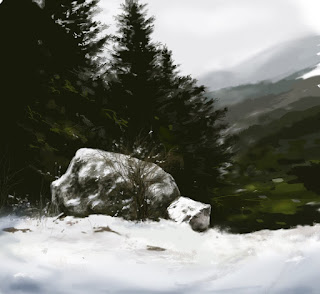One of the properties of light is its intensity. The intensity of the light that falls on an object allow us to perceive the local color of the object and the range of tones of the color between very dark and very light. We use this property of light to determine the quality of the light. Because of this property, in order to create the illusion of light and shade is not only important to follow the rules regarding cool and warm colors but also to the rule of value contrast. The rule to remember regarding value contrast for a given color is:
"The lightest value of a color in the shadow is of darker value than the darkest value of the same color in the light "

This rule is very important when we are painting a sunny scene with wide dynamic range between the shadow and the light areas. In all cases we need to determine, before we start painting, the threshold values of each main color of the painting that will separate the "light family of the colors" and the "shadow family of the same colors". For example, in digital painting we would first create the color notan. This abstract placement of black and white shapes can be replaced by painting masses of the basic dominant colors in the scene. Placing only colors of the shadows family and of the light family. By following the value contrast rule: laying down the large masses of color in such a way that the darkest color that "lives" in the light would never be darker that the lightest color that "lives" in the shadow family. Please see how the value range rule is applied in the gray scale example. I also carefully selected the purple colors in the shadow that were exactly the complementary color to the red and orange colors in the light.
The point is that no matter how intense a given color may seem in the light, is never darker than the lightest value of the same color in the shadow. Notice in the color sketch that the family of reds in the light are never darker than any of the reds in the shadow. In this sketch the purple values are all at or below the Value 140 in the HSV (Hue, Saturation, Value) color model, regardless of the saturation.
 |
| City Sun. Digital painting made with Painter 11. |











